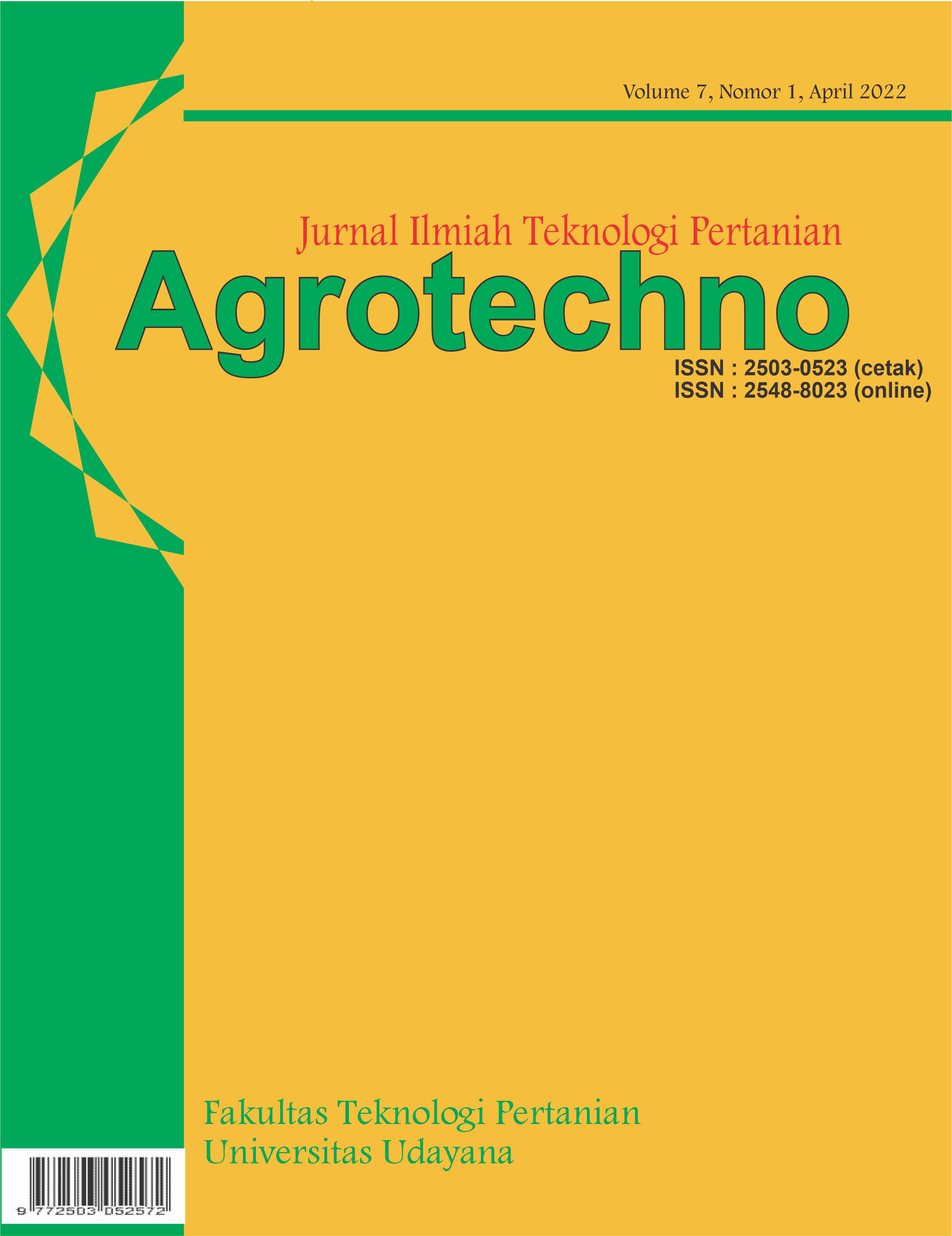Karakteristik Sawi Hijau (Brassica rapa var parachinensis) yang Dihasilkan dari Aplikasi Bakteri Pemacu Pertumbuhan
Abstract
This study tries to use the roots of bamboo plants that grow in Bali as Plant Growth Promoting Rhizobacteria and applied to vegetable plants to see the physical characteristics of these vegetables. This study aims to determine the physical characteristics of greens mustard produced by using the application of growth-promoting bacteria derived from the roots of bamboo (Bambusa maculata). The characteristics of the greens mustard were compared with the use of commercial PGPR (products from Central Java farmers) and without the use of growth-promoting bacteria. Based on the results of the research on the physical characteristics of greens mustard (Brassica rapa var parachinensis) the results of the application of growth-promoting bacteria from bamboo roots obtained plant heights ranging from 39 cm, weight 34 – 44 g, number of leaves 9 – 12 pieces, texture 22.18 – 30.31 kg .m/sec2, brightness level 42.13 – 47.13 and total dissolved solids 4.4 – 5.1% brix, slightly different from the treatment without PGPR and commercial PGPR. For this reason, it is necessary to continue cultivation with growth-promoting bacteria derived from natural ingredients that grow in Bali, this is an effort towards environmentally friendly cultivation so that it is expected to get quality results and are safe for consumption.
Downloads
References
Ahmad, F., Ahmad , I., & Khan, S. (2008). Screening of free-living rhizospheric bacteria for their multiple plant growth promoting activities. Microbiological research, 163(2), 173 - 181.
Backer , R. G., Rokem, J. S., Ilangumaran, G., Lamont, J. R., Praslickova, D., Ricci, E., Smith, D. L. (2018). Plant Growth-Promoting Rhizobacteria: Context, Mechanisms of Action, and Roadmap to Commercialization of Biostimulants for Sustainable Agriculture. Frontiers in Plant Science, 9, 1 - 17. https://doi.org/10.3389/fpls.2018.01473
Bhattacharyya, N. P., & Jha, D. K. (2012). Plant growth promoting rhizobacteria (PGPR): emergence in agriculture. World J Microbiol Biotechnol., 28(4), 1327 - 1350.
Biswas, J. C., Ladha, J. K., & Dazzo, F. B. (2000). Rhizobia Inoculation Improves Nutrient Uptake and Growth of Lowland Rice. SOIL SCI. SOC. AM. J, 64, 1644 - 1650. https://doi.org/10.2136/sssaj2000.6451644x
Deptan. (2013). Go organic dengan PGPR. . Magelang: Dinas Pertanian dan Pangan, Kota Megelang. .
Diyansah, B., Aini, L. Q., & Hadiastono, T. (2013). The effect of PGPR (Plant Growth Promoting Rhizobacteria) Pseudomonas fluorescens and Bacillus 225 subtilis On Leaf Mustard Plant (Brassica juncea L.) Infected by TuMV (Turnip Mosaic Virus). J. Trop. Plant Prot., 1(1), 30 - 38.
Ferdiansyah, Y. (2020). Pembuatan PGPR : langkah kecil pemanfaatan alam. Jambi: For Sustainability Right, Jambi.
Firdausi, N., Muslihatin, W., & Nurhidayati, T. (2016). Pengaruh kombinasi media pembawa pupuk hayati bakteri pelarut fosfat terhadap pH dan unsur hara fosfor dalam tanah. Jurnal Sains dan Seni ITS, 5(2), 53-56.
Grobelak, A., Napora, A., & Kacprzak, M. (2015). Using plant growth-promoting rhizobacteria (PGPR) to improve plant growth . Ecological Engineering, 84, 22 - 28.
Hardiansyah, M. Y., Musa, Y., & Jaya, A. M. (2020). Identification of Plant Growth Promoting Rhizobacteria from Thorny Bamboo Rhizosphere with 3% KOH Gram Test and Gram Staining Test. International Journal of Applied Biology, 4(2), 7-17.
Iswindari, D. (2014). Formulasi dan uji aktvitas antioksidan krim rice bran oil. . Jakarta: UIN Syarif Hidayatullah, Jakarta.
Kurnia, I. A. (2017). Kemasaman Tanah. Kab Buleleng, Dinas Pertanian, Singaraja. Retrieved from https://distan.bulelengkab.go.id/: https://distan.bulelengkab.go.id/informasi/detail/artikel/kemasaman-tanah-32
McMillan, S. (2007). Promoting Growth With PGPR. Canada: The Canadian Organic Grower.
Nur Cahyani, C., Nuraini, Y., & Pratomo, A. G. (2018). Potensi Pemanfaatan Plant Growth Promoting Rhizobacteria (PGPR) Dan Berbagai Media Tanam Terhadap Populasi Mikroba Tanah Serta Pertumbuhan Dan Produksi Kentang. Jurnal Tanah dan Sumberdaya Lahan, 5(2), 887 - 899. https://jtsl.ub.ac.id/index.php/jtsl
Pantastico, E. B. (1989). Fisiologi Pasca Panen, Penanganan dan Pemanfaatan Buah-buahan dan Sayur-sayuran Tropika dan Sub Tropika. (Kamariyani, Trans.) Yogyakarta: Gadjah Mada University Press,.
Rawat, S., & Mushtaq. , A. (2015). Plant Growth Promoting Rhizobacteria, A Formula For Sustainable Agriculture: A Review. Asian Journal of Plant Science and Research, 5(4), 43 - 46.
Sharma, S. B., Sayyed, R. Z., Trivedi , M. H., & Gobi., T. A. (2013). Phosphate solubilizing microbes: sustainable approach for managing phosphorus deficiency in agricultural soils. SpringerPlus, 2(1), 587.
Singh, N. P. (2007). Fruit and Vegetable Preservation. Jaipur, India: Oxford Book Company.
Sukemi. (2019). Cara membuat PGPR (Plant Growth Promoting Rhizobacteria) dari akar bambu. . Cybex Pertanian, Kabupaten Kapuas Hulu.
Triani, I. G., Soemarno, Rahardjo, B. T., & Zubaidah, E. (2020). The Influence of Treatment Variation of Plant Promoting Bacteria In Cultivation On The Quality Of Chinese Cabbage (Brassica rapa L. Ssp. pekinensis). International Journal Of Biology and Biomedical Engineering, 14(2020), 114 - 127. https://doi.org/10.46300/91011.2020.14.17
Wulandari, N., Irfan, M., & Saragih, R. (2019). Isolasi Dan Karakterisasi Plant Growth Promoting Rhizobacteria Dari Rizosfer Kebun Karet Rakyat. Jurnal Dinamika Pertanian, Edisi Khusus(3), 57-64. https://doi.org/10.25299/dp.2019.vol35(3).4565
Yunita, M., Hendrawan, Y., & Yulianingsih, R. (2015). Analisis kuantitatif mikrobiologi pada makanan penerbangan (Aerofood ACS) Garuda Indonesia berdasarkan TPC (Total Plate Count) dengan metode Pour Plate . Jurnal Keteknikan Pertanian Tropis dan Biosistem, FTP, UB, 3(3), 237 - 248.










